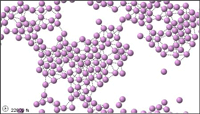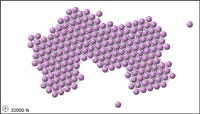

The above image is just an animated gif file. Click the above button or this link to launch this interactive activity.
| In the solid state, atoms do not move much. Mostly, they vibrate around fixed positions. Occasionally, they can exchange their positions, thus causing a slow diffusion. The PCF of a solid will basically show a number of peaks, which represent the nearest neighbors, the second nearest neighbors, and so on. From this information, scientists can determine the structure of the sample crystal. In the liquid state, the motion of atoms is quite different. Atoms do not stay in fixed positions but move around frequently. But because of the compactness in liquids, when an atom moves, it usually will cause the atoms in its vicinity to move. As a result, there is a dynamical structure formation around an atom in liquid phase. If long-range effects can be neglected, we can say that an atom in liquids is surrounded by a dynamical shell structure. The shell structure is dynamic because, if viewed from the perspective of an atom, its neighboring atoms do not stay permanently --- they just stay transiently --- in its vicinity; after a while they leave the atom, the space left behind is then occupied by a newcomer. |


The above image is just an animated gif file. Click the above button or this link to launch this interactive activity. |
| System requirements: You must have Java Version 5 or higher in order to run this program. Please go to java.com to get the latest Java software, if you are not sure. |
| Failed? Check out the FAQ for troubleshooting. |